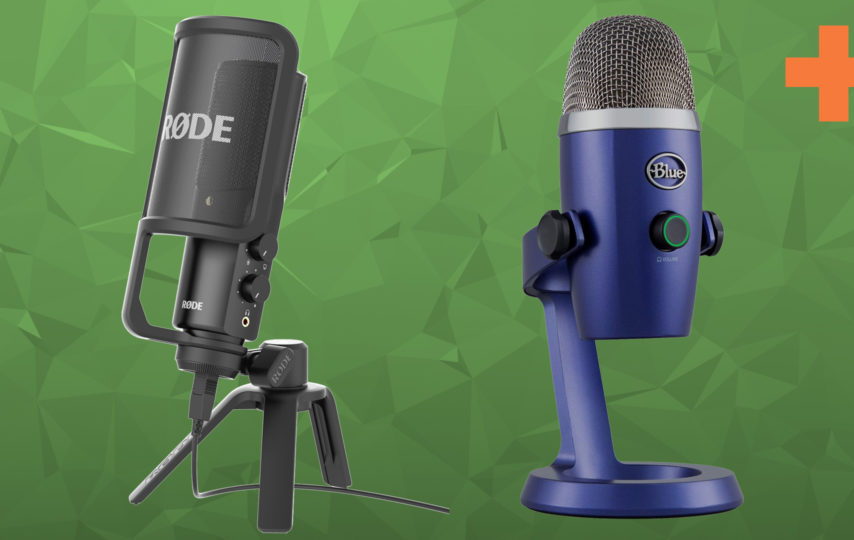Are you a media junky or a multimedia enthusiast? Or maybe you have your own studio. Whether you just want to sing karaoke or want to record professional vocals for voice overs, vlogs or singing tracks, you will always need a condenser microphone to give you the best results. 90 percent of what you see is actually what you hear. Sound has such a great impact on how we perceive things. And if you are trying to convey something through your voice, it should be perfect for it to stand out on its own. For that you must ensure that you have the best microphone. We reviewed some of the best mics for rap vocals. Head over to Bring in the Noise to find the best mic for you.
So, what exactly is a condenser microphone? Condenser microphone are also known as the capacitor microphones. Basically they are metal closely put together giving a capacitance effect.
Condenser mics are developed like that as well. It comprises of a slim layer which is put close to a strong metal plate. The film or the thin membrane, as it is frequently called, must be electrically conductive in case there is any sort of electrical pulses on its surface. The most widely recognized material that is used in the making of these capacitors is the gold-sputtered mylar, however a few (for the most part), utilizes a very slender metal foil.
At the point when sound waves hit the membrane, it moves to and fro in coherence with the strong back plate. The potential difference between the two capacitor plates changes and accordingly, the capacitance changes to the cadence of the sound waves. Voila, we are successful in changing the sound waves into electrical signals.
The container of the signal is excessively “delicate” to be in contact with other bits of the container. The condenser container’s yield voltage is comparatively higher, however, it creates basically no current at all, because the capacitor stores very little energy. It requires an impedance converter to work. An impedance converter is a circuit that cushions between the case and the outside area. The impedance converter makes the sign progressive and clearer by making more current accessible.
If you are new to microphones, going for a new microphone without having prior knowledge of it may proof counterproductive to your interests. There are some serious intricacies that you ought to know before diving into the acoustic ocean. Having a microphone without knowing what to look in it can be bad for your future prospects as bad quality mic will ruin not only your audio quality but will also demotivate you. Let’s face it nobody likes to hear a video recorded from a potato. It just doesn’t turn you on. This all may seem really overwhelming, but fear not as we are here to guide you through this tricky process. Here are some things that you must consider before using a condenser microphone.
Pickup: Ever heard about microphone gain? Why is that option there in most of the systems? It is a tweak that boosts your microphone’s pickup capacity by artificially boosting up the pickup gain and increasing the loudness of the voice. But that is done with the help of software and it actually destroys your sound quality. Different microphones have different pickup variations. Different condenser mics have a different pickup area through which they can pick up sounds which is called the pick-up field. The broader the pick-up field the lesser maneuvering you will have to do with the distance from your mouth to mic. Now there are generally two types of pick-ups that most microphones use. The cardioid pattern and the omni directional pattern. Both are neither good nor bad as it really depends on what kind of sound you really want to record in what kind of environment. If you want to record in an area that has noise you might want to prefer the cardioid but if you want sounds from all directions, it is better to use an omni directional mic like the M1 from Boya.
Proximity: The proximity effect of any mic is its ability to record from a specific distance without lowering down the base and treble of your voice significantly. Ever found your voice to be muddy or muffled where it feels like you are speaking from inside the box. That right there is the microphone limitation kicking in. Before buying that expensive condenser mic, do check its proximity effect first, if you are prone to moving away from your mic while recording. High proximity basically ensures that you get the same result whether you are an inch or a foot away from the mic without destroying the audio quality. If you are a novice vocalist, you might want to look out for this feature.
Power supply: Cheap microphones can operate just on auxiliary power but these professional condenser mics requires some sort of external power supply. If you are a music enthusiast you might know about the phantom power which is designed specifically for powering up these condenser mics. Before investing any money in a good mic, do check if it requires a power input or not. The worst-case scenario that can happen is you standing up to record your audio without providing the mic enough juice to run.
Noise floor: We know going through all these fancy terms and scientific jargon is quite an over whelming endeavor. But bear with us as it will save you from a lot of pain in the future. Noise floor is basically the microphone’s default noise that comes from within itself. These condenser mics are quite sensitive little things. These will pick the slightest vibrations coming from walls, floor and pretty much anything in your studio. Ever heard that annoying hissing or humming sound in your recording that you cancel through audacity? That is most probably because you have a huge noise floor.
Dynamic range: One of the quality features you might want to know about is the mic range. The dynamic range of a mic is its ability to record the lowest lows and the highest highs. The more the dynamic range of a mic, the larger portion of sound it will capture and the clearer your voice will be. If you are doing a professional recording, you want all those highs and lows to be captured for a crisper sound quality. If you are ready to step up to a professional vocalist, do consider investing in a mic that has a high dynamic range.
Microphone diaphragm: So, what is this diaphragm and why does it matter? How will it affect your audio quality? Well, pretty much in every aspect. Basically, all that we have been through above eventually comes down to this. The diaphragm of the mics will decide how well the mic stands up to the above-mentioned metrics. All condenser mics come in two types of diaphragm. The large diaphragm and the small diaphragm. There has also been a recent development which they call a medium diaphragm. Larger is better in this case. The larger the diaphragm the higher the dynamic range and the pickup of the mic. Now that does not essentially mean that mics with smaller diaphragm are any worse. As mentioned before, it really depends on your preference and your application. Larger diaphragm mics are best for recording instruments in a studio while the small and medium diaphragm mics are best suited to record your vocals. If you are using your mic only for voice overs, then mics with smaller diaphragm will work just as well.
Frequency patterns: Almost every high quality receiver will provide with a chart of its recurrence frequency. A microphone’s recurrence reaction is an estimation of the extent wherein it reacts to some random frequency on the go. Certain mics will attain more highs or more lows which depends on using different mouthpieces. It’s one of the fundamental reasons that you may like utilizing one mouthpiece for a specific source and another for some other.
Realizing how an amplifier reacts to specific frequencies will totally impact your choice on buying that mic. In case you will utilize this amplifier to record vocals for yourself, what are the frequencies do you end up with while previously restraining with your equalizer when you record your voice for a voice over? On the off chance that you are able to do about 6k at 5 db, do you truly need a mic that has a tremendous knock in that recurrence frequency? You may spare yourself a great deal of your precious time by finding a mic that supplements your necessities.
In the end it is your choice to decide which one to go with. While the contrasts among condenser and and dynamic mics can be seen in account, but if you are acquainted with terms like directionality, impedance, and recurrence reaction, you are more likely to make a good purchase before you make your last determination. Do especially consider the direction factor as it will have a huge impact on your recording which makes a difference whether your content stands out or not.








